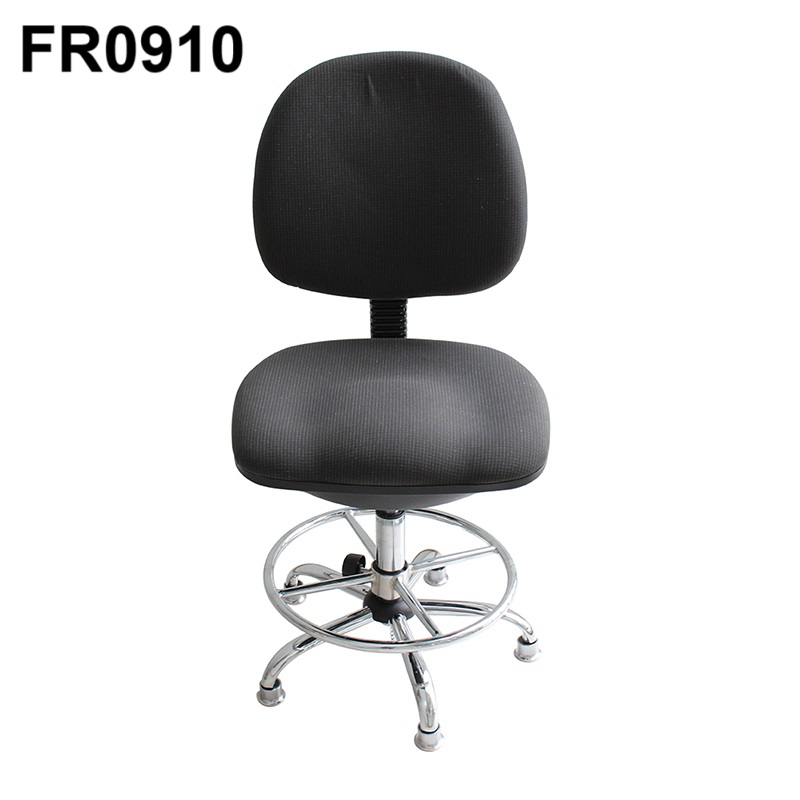FR0910 ESD Antistatic PU Chair
1) Material: Anti static PU Leather
2) Color: Black, Blue
3) Dimension: 430 * 400mm (chair seat) , 400*300mm ( Chair Back)
4) Adjustable height: 460-600mm
5) Surface Resistance:10^4-10/^9ohm
6) System resistance:<=10^9ohm
7) Accessories: Steel chroming five star foot, High strength die casting chroming A-alloy, conductive metal chain
Products
Products DETAILS
FR0910 ESD Antistatic PU Chair
-
Conductive Fabric or Vinyl: The seat and backrest are covered with static-dissipative material that allows the flow of electrons, reducing the buildup of static electricity.
-
Metal Components: The frame, base, and casters are made with conductive materials to help direct static charges away.
-
Grounding Chain or Strap: Some ESD chairs come with a grounding chain or strap that touches the floor, ensuring a proper connection to the grounded surface.
-
Conductive Casters or Glides: These prevent static buildup while allowing mobility.
-
Available in ESD fabric, ESD vinyl, and polyurethane options.
-
ESD vinyl and polyurethane are preferred in cleanrooms because they are easy to clean and do not generate dust.
-
Equipped with static-dissipative wheels or glides.
-
Some models include a grounding cable or wrist strap attachment for added safety.
-
Height-adjustable seat with pneumatic lift.
-
Adjustable backrest and lumbar support for comfort.
-
Armrests (optional) made from conductive materials.
-
Meets ANSI or ESD S20.20 and IEC 61340-5-1 standards.
-
Some models also comply with ISO 14644 for cleanroom compatibility.
-
Electronics Manufacturing – Protects circuit boards and semiconductors.
-
Cleanrooms – Prevents contamination while dissipating static charges.
-
Laboratories – Ensures safe handling of sensitive electronic testing equipment.
-
Medical Device Manufacturing – Prevents electrostatic damage to critical components.
-
Data Centers – Avoids static-related failures in servers and storage devices.
-
Material: Choose fabric, vinyl, or polyurethane based on your work environment.
-
Adjustability: Ensure height and backrest adjustments for ergonomic comfort.
-
Mobility: Decide between casters for mobility or glides for stationary use.
-
Weight Capacity: Check the chair’s maximum load-bearing capacity.
-
Certification: Look for compliance with ANSI or ESD and IEC standards.
-
ESD Antistatic Chair: A Complete Guide
An ESD (Electrostatic Discharge) Antistatic Chair is a critical component in ESD-protected environments where sensitive electronic components are handled. These chairs are designed to dissipate static electricity safely and prevent electrostatic discharge that can damage semiconductors, circuit boards, and other electronic devices.
1. How Does an ESD Chair Work?
ESD chairs are built using conductive and dissipative materials to ensure that any static charge generated by a person is safely transferred to the ground. The main components that enable this include:
2. Key Features of ESD Antistatic Chairs
a) ESD-Safe Materials
b) Grounding Capabilities
c) Ergonomic Adjustments
d) Compliance with Industry Standards
3. Where Are ESD Chairs Used?
ESD antistatic chairs are commonly used in:
4. Choosing the Right ESD Antistatic Chair
When selecting an ESD chair, consider:





